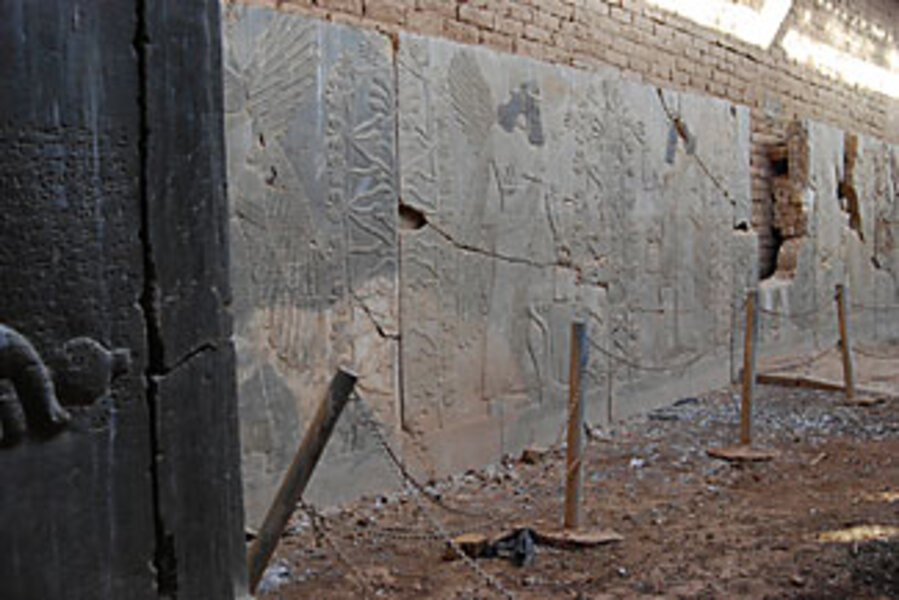Iraq: No haven for ancient world's landmarks
Loading...
| Nimrud, Iraq
The carved stone reliefs lined the entrance to a great palace, a testament to one of the most powerful kings the world has known. The ancient works of art have stood for 3,000 years but for the past 20 they've been threatened by the lack of a corrugated steel roof.
One of the prizes of archaeology, the excavated palace of Ashurnasirpal at Nimrud, is in peril. The World Monuments Fund lists Nimrud as one of its most endangered sites.
Exposed to the elements, the reliefs are quickly deteriorating, experts say. Without basic maintenance, they will decay further and modern society will lose an important portal into the life of one of the great warrior kings and the beginnings of civilization.
Here on the banks of the Tigris River, King Ashurnasirpal II built a six-acre palace of cedar and exotic woods. The walls were lined with glazed and painted seven-foot-high stone bas reliefs of his epic battles. Inside, furniture was inlaid with the most delicate ivory carvings. When the palace was completed around 869 BC, 70,000 guests attended a feast that lasted 10 days.
Now, inside the North West Palace, dead birds lie at the feet of the mythical beings depicted on the alabaster panels. Droppings from pigeons flying in and out of the broken windows stain the seven-foot-high reliefs of King Ashurnasirpal and the winged genies that protected him. The weather has softened the sharp details of feathers carved by craftsmen 3,000 years ago, as well as the cuneiform inscriptions below them.
Outside, the soft stone of a huge, intricately carved winged bull guarding the entrance to the palace has been pockmarked by rain coming in from gaps in the makeshift metal roof and by blowing sand. Mold creeps from cracks in some of the carvings.
From 883 to 859 BC, King Ashurnasirpal ruled an empire that included Iraq, lower Egypt, the Levant, and parts of Turkey and Iran.
Today, only the wind whistles through what's left of his excavated palace. Pigeons roost from the rotting timbers while guards who have no fuel for their vehicles – or even flashlights – patrol an archaeological treasure that few people visit. Outside, one of the guards sits on a mattress laid out next to a mud brick hut with broken windows.
"It's a place that's just been neglected," says the Iraqi site manager. Despite improving security in the area, he says he's afraid to give his name. "Before, there was more attention paid to it. From the occupation to date, there has been no renovation at all – there's no money."
For nearly 20 years, there's been little money for upkeep. Under United Nations sanctions following Iraq's 1991 invasion of Kuwait, Iraq was barred from importing even rudimentary conservation materials. That's when the site began to fall into disrepair. After the US invasion in 2003, thieves sawed off two large pieces of the reliefs.
Unlike the systematic looting at archaeological sites in the south of Iraq, the main problem here has been one of neglect.
Nimrud and other Assyrian capitals have been on the World Monuments Fund list of most endangered sites since 2002. The fund says looting, lack of conservation, and an economic crisis have placed them in jeopardy of eradication.
"My sense is they are suffering from a lack of attention more than any kind of willful destruction – what we call in the conservation business 'demolition by neglect,' " says Suzanne Bott, a conservation expert with the US State Department's Provincial Reconstruction Team in Mosul.
"The ones that have been exposed to the elements are deteriorating terribly fast. It's not so much a willful process, because nobody wants it to happen, but it's the state of affairs in a country where there hasn't been so much of an emphasis on preservation," says Ms. Bott, who has worked on getting US and UNESCO funding to fix the roof and replace broken windows in the palace.
A recent UNESCO mission has highlighted severe signs of water infiltration, erosion, and neglect at the site, including decaying limestone and marble brick carvings. The UN agency has pledged to repair one of the walls at the site in danger of collapse.
Known in the Bible as Calah, Nimrud is believed to have first been settled in 5000 BC.
At its height, 60,000 people lived in the royal city, which was surrounded by five miles of walls and contained parks and gardens. Most of the spectacular panels found in the excavated throne room in the mid-1800s were taken away to the British Museum. Smaller pieces were sold to collectors – a common custom at the time.
But the most dazzling find – unearthed in the late 1980s – is one of archaeological legend. An excavation led by Iraqi archaeologist Muzahim Mahmood came across a royal tomb the British archaeologists had missed. Crawling deep into a hidden vaulted room, he discovered one of the spectacular treasure troves of the last century – hundreds of pieces of gold jewelry and ceremonial objects for an Assyrian queen.
"The whole of Nimrud is a treasure in and of itself," says Dr. Mahmood, who dreams of excavating more of the 95 percent of the royal capital still underground.





